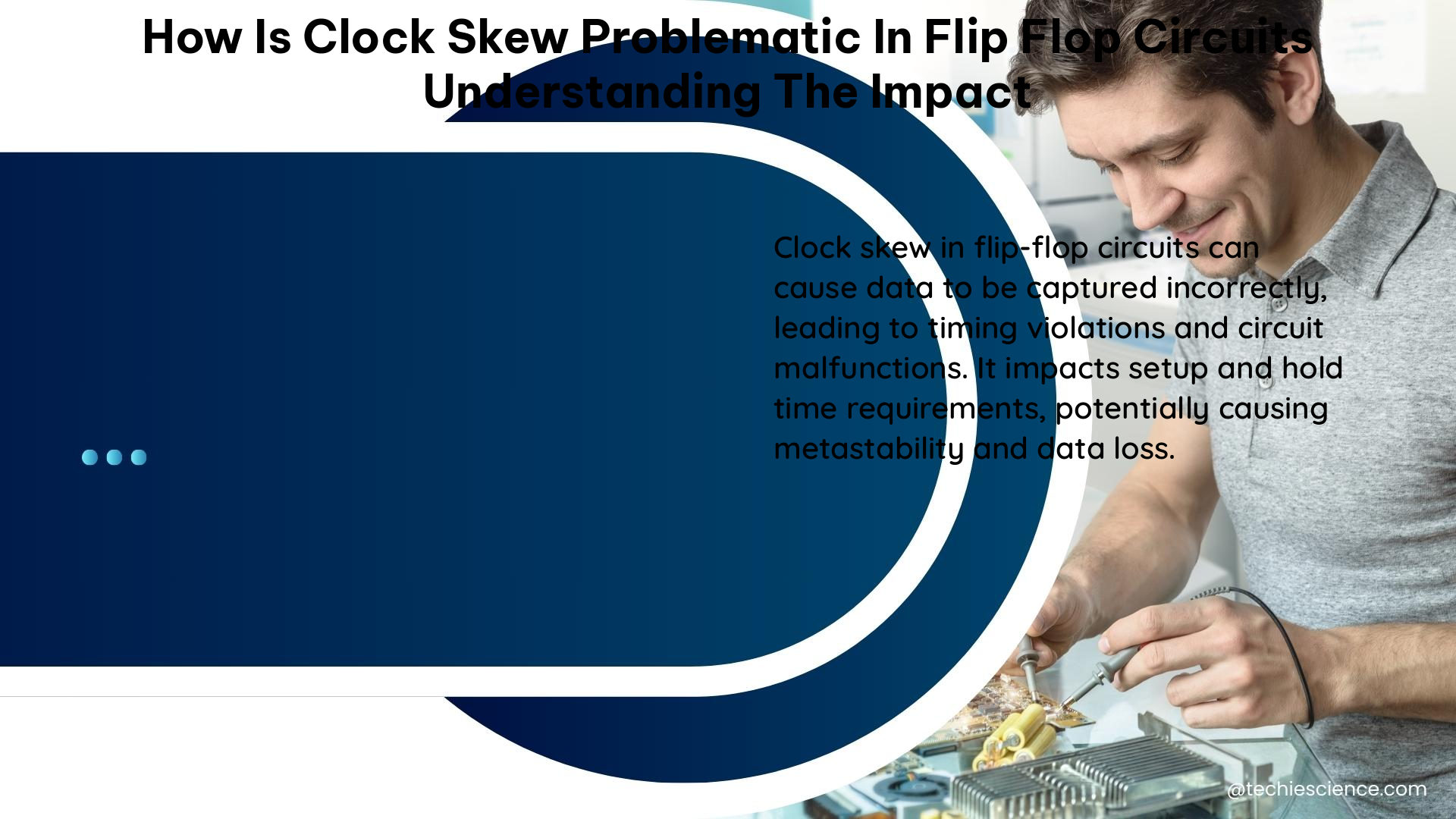Clock skew is a critical issue in synchronous digital circuits, and it can be particularly problematic in flip-flop circuits. This article will provide a comprehensive understanding of how clock skew affects the operation of flip-flop circuits and the impact it can have on their performance.
What is Clock Skew?
Clock skew is the phenomenon where the clock signal arrives at different components in a digital circuit at slightly different times. This can occur due to various factors, such as variations in the length of the clock distribution network, differences in the propagation delays of the clock buffers, or even temperature and voltage fluctuations.
Impact of Clock Skew on Flip-Flop Circuits

In flip-flop circuits, clock skew can have a significant impact on the circuit’s operation, particularly with respect to setup and hold times.
Setup Time Violations
Setup time is the minimum time required for the data input to a flip-flop to be stable before the active edge of the clock signal. If the clock signal arrives at a flip-flop before the data input has had sufficient time to stabilize, a setup time violation can occur. This can cause the flip-flop to latch the wrong data, leading to errors in the circuit.
The impact of clock skew on setup time can be quantified as follows:
- Let’s assume the clock signal arrives at the first flip-flop at time t1 and the second flip-flop at time t2, where t2 > t1.
- If the combinational logic delay between the two flip-flops is less than (t2 – t1), then the data input to the second flip-flop may not have had enough time to stabilize, leading to a setup time violation.
- The magnitude of the setup time violation is directly proportional to the difference (t2 – t1), which is the clock skew.
Hold Time Violations
Hold time is the minimum time required for the data input to a flip-flop to remain stable after the active edge of the clock signal. If the clock signal arrives at a flip-flop before the data input has had sufficient time to stabilize, a hold time violation can occur. This can cause the flip-flop to latch the wrong data, leading to errors in the circuit.
The impact of clock skew on hold time can be quantified as follows:
- Let’s assume the clock signal arrives at the first flip-flop at time t1 and the second flip-flop at time t2, where t2 > t1.
- If the combinational logic delay between the two flip-flops is very short, the output of the first flip-flop may change before the hold time condition for the second flip-flop is satisfied.
- The magnitude of the hold time violation is directly proportional to the difference (t2 – t1), which is the clock skew.
Metastability Issues
Clock skew can also lead to metastability issues in flip-flop circuits. Metastability occurs when a flip-flop is triggered at a time when the data input is not stable, causing the flip-flop to enter an indeterminate state. This can lead to unpredictable behavior and errors in the circuit.
The probability of metastability increases as the clock skew increases, as the likelihood of the clock signal arriving at the flip-flop when the data input is not stable also increases.
Measuring the Impact of Clock Skew
To measure the impact of clock skew on a flip-flop circuit, engineers can use specialized tools and techniques, such as:
-
Timing Analysis: Using tools like static timing analysis (STA) or dynamic timing analysis (DTA), engineers can analyze the timing of the clock signal and the data inputs to the flip-flops, identifying any setup or hold time violations.
-
Clock Skew Measurement: Engineers can use specialized test equipment, such as high-speed oscilloscopes or logic analyzers, to directly measure the clock skew between different points in the circuit.
-
Simulation and Modeling: By creating detailed models of the circuit, including the clock distribution network and the flip-flops, engineers can simulate the impact of clock skew and predict the potential issues that may arise.
-
Experimental Validation: Engineers can also perform physical experiments on the circuit, such as introducing controlled clock skew through the use of delay lines or other techniques, to validate the impact of clock skew on the circuit’s performance.
Mitigating the Impact of Clock Skew
To mitigate the impact of clock skew in flip-flop circuits, engineers can employ various techniques, such as:
-
Clock Tree Optimization: Designing a well-balanced clock distribution network with minimal variations in the clock path lengths can help reduce clock skew.
-
Clock Skew Absorbing Flip-Flops: Specialized flip-flop designs, such as the clock skew absorbing flip-flop, can be used to reduce the sensitivity of the circuit to clock skew.
-
Timing Margin Adjustment: Increasing the timing margins, such as the setup and hold times, can help the circuit tolerate larger amounts of clock skew without experiencing timing violations.
-
Redundancy and Error Correction: Implementing redundancy in the circuit, such as using multiple flip-flops to store the same data, can help mitigate the impact of clock skew-induced errors.
By understanding the impact of clock skew on flip-flop circuits and employing appropriate mitigation techniques, engineers can design more robust and reliable digital systems.
References
- Clock Skew – an overview | ScienceDirect Topics
- A clock skew absorbing flip-flop – Electrical and Computer Engineering
- Clock skew – Wikipedia
- How does the clock skew affect the design?

The lambdageeks.com Core SME Team is a group of experienced subject matter experts from diverse scientific and technical fields including Physics, Chemistry, Technology,Electronics & Electrical Engineering, Automotive, Mechanical Engineering. Our team collaborates to create high-quality, well-researched articles on a wide range of science and technology topics for the lambdageeks.com website.
All Our Senior SME are having more than 7 Years of experience in the respective fields . They are either Working Industry Professionals or assocaited With different Universities. Refer Our Authors Page to get to know About our Core SMEs.